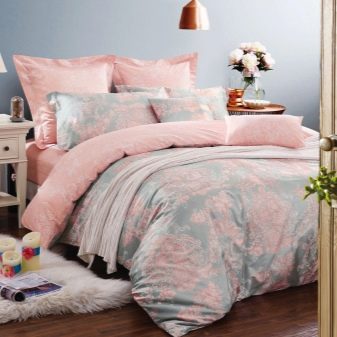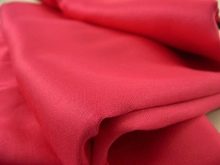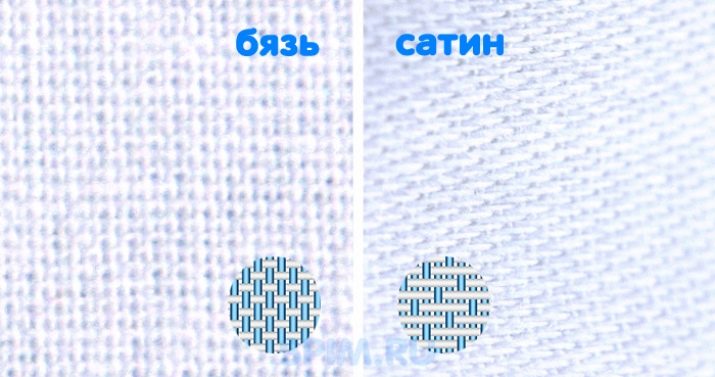Properties and types of satin

Tissues surround us from birth. Bed linen, clothes are what we meet every day. You can make these meetings more enjoyable by choosing high-quality fabrics, such as the many types of satin.
What is this fabric?
The history of the matter called "satin" originates in China. The fabric was invented back in the XII century, and took its name from the Chinese harbor of Zaytun. Satin in those days was made from natural silk threads, and therefore was available only to wealthy citizens of the country. Luxurious robes, formal dresses adorned the bodies of famous beauties, delighting them with coolness and perfect smoothness.
In Europe, fabric appeared much later, namely in 1850. As in China, only a few could afford to wear an outfit made of such matter, but the 20th century radically changed the position of satin. So, silk threads were replaced by cotton ones, which made the fabric much more affordable.

The description of the material cannot but rejoice, because it includes such epithets as:
- smooth;
- brilliant;
- soft;
- wear-resistant;
- bright.
Natural satin looks akin to silk or satin, and therefore it will not be difficult to recognize it. It is easy to drape it in intricate folds or straighten it in one movement, shaking the matter. Unlike silk fabrics, it retains heat well and gives it to its owner.


Composition
Satin got its name due to the weaving method, and therefore various threads can be used in its manufacture. So, the most popular is pure cotton fabric with a density of 85-130 threads.This composition allows you to create high-quality and attractive bedding sets with a high degree of wear resistance.
Synthetic satin (or blended), in addition to cotton, has polyester threads in its arsenal. The mixture of fibers allows them to be used as a base for clothing and bedding. Note that synthetic satin is more durable and democratic, but inferior in tactile characteristics.
When fabric of increased density is needed, double satin is used. In its composition, threads of cotton and viscose are intertwined. A similar fiber is used for the lining.


As mentioned earlier, satin was made from silk fibers in China. Today silk threads are also used in the creation of fabric, however, as an addition to cotton. Satin satin can also be made from fully synthetic yarns. With the use of silk or synthetics, the fabric has a special shine and gloss.
Cotton and fleece are another possible pairing for satin. The outer side of the fabric is smooth, while the inner side retains the warmth and versatility of the fleece. The so-called "mansi" satin is widely used to make bedspreads and rugs.
One cannot but mention one more composition that is possible for satin. Mako-satin, amazing in its properties, is made from Egyptian cotton, surprising with its brilliance with an absolutely natural composition.


Manufacturing technology
Satin is a fabric that requires special attention to manufacturing techniques. So, the fabric appears exclusively thanks to the loom, as it was centuries ago. In China, satin was created on hand-held looms, and the process was mechanized only in the 17th century.
The beginning of work in the creation of delicate matter is the preparation of cotton, because the fibers must have special strength and shine. For this, the threads are treated with various alkaline and acidic solutions, in other words, they are mercerized.
The number of threads can be used differently, which determines the future density of matter. For example, there can be 5 threads, four of which will be used for the warp, and the fifth for the weft thread. A thin and tightly twisted thread is used as a weft thread, due to which the effect of a glossy silk surface is achieved. The seamy side of the fabric has no shine, since the warp threads prevail in it, while the front side sparkles with the shine of a tightly twisted weft thread.
When the canvas is ready, it is bleached and dyed.
Painting methods:
- pigmentary;
- reactive.
Reactive dyeing is preferable, because the product obtained with its help does not lose its color even after several hundred washes. The secret lies in the dyes, which literally eat into the fibers. Pigment coloring allows you to apply paint only on the front side, which is not a very high-quality option.

Varieties
Today you can find a huge number of satin options. Cotton is blended with various fibers to form unions that are unlike each other. Consider the most popular types for making bed linen.
- One of the popular types of matter is satin jacquard. Its high wear resistance is due to its good density of 200 fibers per square meter. In appearance, the material resembles printed silk, since it does not have a front side. The beauty of satin jacquard lies in the intricate patterns that rise slightly above the base of the fabric.



- Note that there is in the weaving industry and printed satin, irreplaceable for sewing curtains. The pattern on it consists of interweaving threads of various colors. At the same time, the pattern has no beginning or end, representing a beautiful canvas.


- Printed satin is the opposite of printed satin. In this case, the drawing is applied to the finished canvas using paints.Such matter turns out to be even denser and stronger, and the image pleases with brightness and saturation. The fabric with this method of dyeing is called "ecosatin", since the dye is applied only to the front side, and therefore does not come into contact with the skin.
Experts recommend using ecosatin for people prone to allergies, as well as for children.


- Silk satin - one of the newest varieties of elite satin. It is excellent for use as a base fabric for curtains, bedding and clothing. This variety has cotton threads at the base and a twisted silk thread for the front side.



- Another elite type of matter - mako satin. As mentioned earlier, only Egyptian cotton fibers are used to create it, which are distinguished by their density and fineness. Tightly twisted threads can decorate any style of a dressing gown, blouse or dress for special occasions.


- For solemn and festive fabrics include satin corduroy. Its velvety and lightness makes it possible to sew weightless and textured clothes.
- A good combination of two types of fibers is soft satin. In addition to cotton, it uses viscose fibers. Thanks to the viscose yarns, the soft satin product does not wrinkle and does not change its presentable appearance even after 300 washes.


- Synthetic fabrics are also a good choice. So, gloss satin, made of polyester fibers, has proven itself as a fabric for sewing covers. Its peculiarity lies in the application of a silvery paint to the fabric. Also, gloss satin is famous for its high strength, and therefore finds love among consumers.
- The finest threads of polyester, diluted with cotton fibers, form a weightless fabric called "Slim satin". It is successfully used to create bed linen for adults and children, because among its advantages is crease resistance and quick drying. In addition, the slim satin is non-slip and looks great after numerous washes. Reactive dyeing of slim satin eats into the fibers of the fabric, pleasing with a decent appearance for a long time.


Advantages
Satin clothing and underwear has long acquired its admirers. Numerous reviews testify to the love for the material carried through the years, and sometimes generations. For example, parents buy bed linen for themselves and their children for housewarming, as well as for grandchildren and relatives, knowing that it is not better and more practical to find a gift.
Most of the fabric's advantages lie in its naturalness. Pure cotton provides:
- lack of possible manifestations of allergies;
- "Breathing" of the body;
- pleasant tactile sensations;
- lack of toxic substances;
- heat preservation.
Other advantages come from the special weave of the threads. So, satin linen has:
- incredible brilliance;
- density;
- silkiness;
- presentable appearance;
- lack of creases.
Satin linen is a godsend for those who value their time. Once purchasing sets from it, you can forget about the endless smoothing of bed linen, as well as frequent changes due to the loss of performance.

disadvantages
Owners of satin linen, as a rule, reject any attempts to find flaws in this material. However, only a sober analysis of the characteristics of the fabric will subsequently help to meet their expectations.
The first subjective disadvantage is the high cost of natural sateen. The absence of synthetics makes matter noble, and therefore it is not available to every wallet. Note that satin lovers justify the high price by long-term operation.
The second drawback is considered by some to be the excessive silkiness of the matter. Bed linen slips, and therefore it is not very comfortable to sleep on. Cotton pajamas and underwear sets solve the problem.
Another feature is the impossibility of using matter on hot days.According to the owners, it is hot to sleep in satin underwear in summer, while in winter it is very comfortable and cozy.

Comparison with other materials
Often, lovers of high-quality lingerie are at a loss as to which material to choose. Despite the fact that most fabrics use cotton, the difference between them is great.
When buying bedding sets, consumers often choose between:
- satin;
- poplin;
- calico.
To understand which is the best of them, a table with the main characteristics will help, which can be found in many suppliers who want to not only sell fabrics, but also explain the main differences to the buyer.
Comparative characteristics are based on the following criteria:
- appearance;
- price;
- softness;
- wear resistance.



Looking closely at the drawing, skillfully executed on a loom, you will notice that coarse calico, poplin and satin are completely different fabrics. For example, satin is characterized by smoothness and silkiness of the front side. Poplin does not have such a shine, conquering consumers with weaving in the form of a hem. Such a pattern can be obtained by interweaving threads of different thicknesses and their further connection. Calico is simple and easy to manufacture, and the pattern of its threads forms the usual cross-shaped steps.

And if in appearance the leaders can be considered satin and poplin, then the cost cannot be found equal to coarse calico. She is really very democratic and, when choosing a high-quality kit, can serve for a long time.
Softness is an important criterion for judging fabric, especially when it comes to clothing and bedding. The finest silk-like sateen fibers significantly outperform other competitors. Poplin rightfully takes the second place, while the last medal is given to coarse calico. However, sometimes coarse coarse calico weaving, on the contrary, becomes a plus, because spending night hours in such a bed, you can combine sleep and micro-massage of the whole body.

The level of wear resistance directly depends on the quality of the laundry. So, if satin and poplin, when mixing natural fibers with synthetic ones, do not lose their durability, then coarse calico quickly forms unsightly pellets.
In the event that the choice is between natural competitors, then each material pleases with its durability. Density from 120 threads per 1 sq. cm provides strength, as well as no shrinkage. Note that with improper care, poplin can deform and shrink in its original size.
As you can see, there is no consensus on the choice of fabric, because a lot depends on the priorities of the buyer at a given time.

Selection Tips
Going in search of quality satin, it is important to remember which places of sale are best to bypass. Street stalls and markets rarely purchase natural materials based on the income level of the segment of shoppers who visit them. Wanting to buy luxury lingerie, it is wiser to contact specialized salons in the city.
Tactile characteristics of good satin:
- the material does not stretch and does not shine through;
- does not have a pungent smell of paint and low-quality dyes;
- quite dense, as evidenced by the data on the label (density from 110 threads).
Paying attention to the product label, it is important to take into account the composition of the fabric. Of course, 100% natural fibers are a priority, but children's underwear sets are often diluted with a fraction of synthetics for faster drying.
One should be wary of satin "Denia", which does not have official information about the composition and density, as evidenced by a huge number of negative reviews in his direction.
Care advice
Satin underwear is not a cheap pleasure, and therefore it is important to organize proper care of the material.
- You can wash it by any means at a temperature not exceeding 40 degrees.
- It is also allowed to wring out the laundry in the machine, but it is worth remembering that high revolutions can provoke the appearance of creases.
- The laundry tolerates ironing well.Women's satin clothing lends itself well to steam ironing.
- The white and colored material is loyal to any kind of powder and conditioner. If you want to bleach fabrics, you can use any bleach with confidence.


For an overview of crepe satin fabric, see below.








